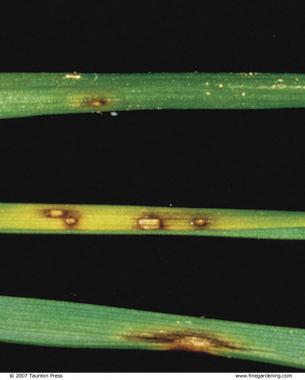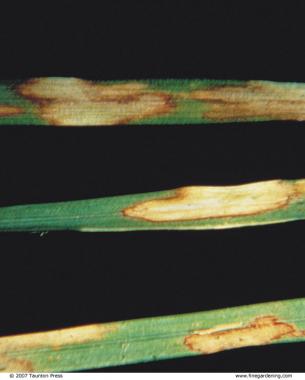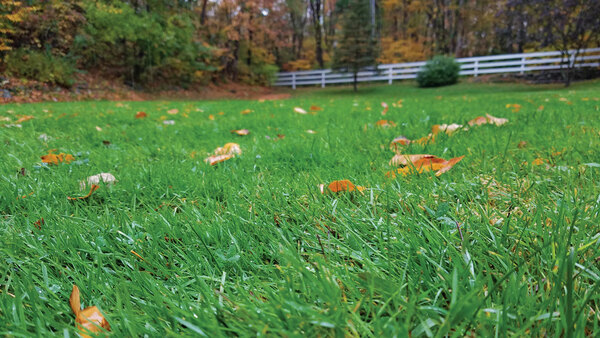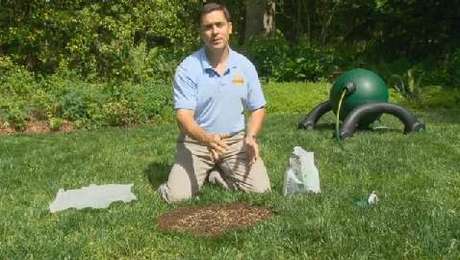It’s spring and your lawn furniture is all in place, just screaming for a backyard barbeque. While you’re contemplating whether to serve chicken or steak, your plans come to a screeching halt when your neighbor leans over the fence and asks, “What’s up with your lawn?” as he points to the ugly patches of brown grass scattered across your playground of green carpet.

Photo/Illustration: John Fech

Unhealthy spots of grass in a lawn can be caused by several factors, like compacted soil, uneven fertilizer application, insect infestation, lawn mower injury, pet damage, and too much or too little water. But in spring, the major culprits to consider are disease-causing fungi. Many lawn diseases appear at this time of year, when the grass actively begins to grow and when fungus-spreading moisture and wind increase. Two wide-spread fungal diseases are Bipolaris leaf spot and Rhizoctonia brown patch.
Bipolaris leaf spot is the most common springtime disease that affects northern cool-season grasses. Early symptoms are small, dark-purple to brown spots with buff-colored centers surrounded by a dark-purple margin on the grass blades. As the disease progresses, infected blades turn yellow, and eventually the crown of the plant dies. The affected area takes on a dull, weathered look.


Since this malady is easier to prevent than to cure, I recommend ripping out the problem areas and reseeding with improved disease-resistant cultivars. Practicing sound maintenance techniques also wards off fungal diseases. Begin by avoiding over-fertilization, reducing the thatch layer to 1/3 to 1/2 inch thick, and watering only enough to keep the roots moist. Prevent prolonged periods of moisture on the leaf blades by watering in the early morning hours, so the grass has plenty of time to dry during the day.
For lawns with a history of Bipolaris leaf spot, consider applying a liquid fungicide (with one of the active ingredients propiconazole, mancozeb, or thiophanate-methyl) according to label directions. Apply the first treatment a week or two after spring green-up and continue with two to three applications, spaced two to three weeks apart.
Rhizoctonia brown patch is a perennial springtime fungus that affects primarily southern warm-season grasses. Infected lawns show brownish-yellow patches or rings of dead and dying grass.. The patches may reach 2 to 3 feet in diameter with grass blades that can be matted down but are typically standing straight up. Green grass blades within the diseased patches are usually marked with irregularly shaped, damaged areas surrounded by a darkbrown margin.
As with Bipolaris leaf spot, the emphasis for controlling Rhizoctonia brown patch should be placed on preventive practices rather than on chemical strategies. Again, avoid over-fertilizing, which can stimulate too much lush growth, and when watering, do not allow the grass blades to be wet for more than six hours. On highly susceptible turfs, like St. Augustinegrass, begin liquid fungicide treatments (with a product containing triadimefon, propiconazole, thiram, thiophanate-methyl, or mancozeb as an active ingredient) at the first sign of the symptoms. As with any fungicide product, be sure to read and follow all label directions and warnings.
If you are unsure if your lawn has a disease, take a grass sample to your local extension agent or garden center for help in correctly diagnosing the problem. Lawn disease prevention and control will help you to enjoy a healthy lawn all season long. You’ll be back in business, throwing those backyard barbeques before you know it.
Fine Gardening Recommended Products

SHOWA Atlas 370B Nitrile Palm Coating Gloves, Black, Medium (Pack of 12 Pairs)
Fine Gardening receives a commission for items purchased through links on this site, including Amazon Associates and other affiliate advertising programs.

Corona High Performance Orchard Loppers
Fine Gardening receives a commission for items purchased through links on this site, including Amazon Associates and other affiliate advertising programs.


















Comments
hi what should i do if my grass is not doing well?
Thank you for sharing this info. I had tried ask my tree service winnipeg guy about this but he said he didn't know. Now I know and thank you for it!
Log in or create an account to post a comment.
Sign up Log in